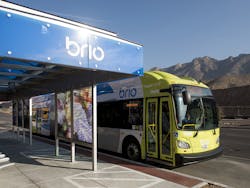Almost a decade ago, forward-thinking leaders at the city of El Paso, Texas, set an ambitious goal: To revolutionize public transportation in El Paso by making it the least car-dependent city in the southwest. In 2006, the city hired First Transit Inc. to manage Sun Metro, the city’s mass transit department, and transform it into a first-class public transportation system. Next, Sun Metro began planning a new rapid transit system. In October 2014, Sun Metro took a major step to turn this vision into a reality when it introduced El Paso’s first bus rapid transit (BRT) service — Brio — along the Mesa Corridor.
The 8.6-mile Mesa Corridor, which runs from the Santa Fe Transfer Center to the Westside Transfer Center at Resler, is the first of four rapid transit corridors planned in El Paso. The second corridor, Alameda, is scheduled to begin construction in fall 2016. Beginning at the Downtown Transfer Center, the 14.5-mile corridor will travel primarily along Alameda and include service to the Five Points Transit Terminal and Mission Valley Transfer Center. Dyer and Montana, the third and fourth corridors, are tentatively scheduled to be operational in 2017 and 2019, respectively. The four corridors, totaling $145 million, are funded using a combination of Federal Transit Administration (FTA), Federal Highway Administration (FHA), and Texas Department of Transportation (TxDOT) and city of El Paso dollars.
“Mesa Brio is just the beginning of what’s to come for El Paso,” said Sun Metro Director Jay Banasiak. “Our ongoing objective is provide a first-class transportation system that moves our family, friends and neighbors to get to work, to school, to visit each other and back. It is also a system that supports our economic development, reduces traffic congestion and helps improve our community’s air quality.”
To successfully complete this project, the city of El Paso commissioned Lockwood, Andrews & Newnam Inc. (LAN) to provide design and engineering services along the Mesa and Alameda Corridors. To construct the Mesa Corridor, the city hired Martinez Brothers Contractors LLC.
Brio Features
Brio offers several distinctive features that enable El Paso residents to travel faster and with more comfort. Uniquely branded 60-foot articulated buses transport more than 70 passengers between the terminal stations every 10 minutes during peak periods and 15 minutes during off‐peak periods for 14 hours a day, Monday through Friday (20 minute service on Saturdays). The low-floor Brio vehicles run on compressed natural gas (CNG) and have three doors for faster boarding. Passenger amenities also include pre-paid ticket vending and controlled traffic signals to move riders more efficiently, an audio/visual system to provide destination and next-stop information inside and outside vehicles, bicycle racks, Wi-Fi connections and wheelchair accommodations.
The Mesa and Alameda Corridors feature 22 and 29 BRT transit stations, respectively. The stations, which are each spaced less than a mile apart, contain custom-fabricated metal screens displaying dramatically enlarged photographs of local plants and flowers to enhance the rider experience. Each station is approximately 13 feet tall with six or nine-foot wide canopy structures — bigger than typical bus stops — to support wayfinding and allow enough shade for the commuters. The stations are also equipped with aluminum grills on the fronts and backs of the stations to combat the bright sunlight and extreme heat in El Paso. The station areas include two bus shelters at each stop, street lighting, landscaping, bike racks, ADA‐accessible ramps and station platforms, and reconstructed sidewalk at all approaches.
“Brio’s biggest draw is its speed and reliability,” said Banasiak. “Riders especially appreciate the fact that they can use a dependable service that doesn’t require a schedule.”
Community Benefits
Thanks to Brio, the city of El Paso is experiencing a number of benefits. Thousands of commuters along the Mesa Corridor now enjoy affordable, reliable access to local universities, medical centers and downtown cultural attractions, including the University of Texas at El Paso, El Paso Community College, Providence Memorial Hospital, Las Palmas Medical Center, and the El Paso Museum of Art. The Alameda Corridor, once completed, will serve the University Medical Center and El Paso Children's Hospital, as well as three high schools.
Since its introduction, the number of people using Brio has grown steadily with more than 52,000 commuters using the service every month, well exceeding Sun Metro’s ridership projections. This has helped pull hundreds of cars off the road each day and a reduction of almost 19 metric tons of carbon dioxide during the first year of operation.
The project also has created numerous transit-oriented development opportunities. Along the Mesa Corridor, as many as 20 housing, retail and office space developments have occurred during Brio’s implementation. Of these 20, there were 14 brand new business developments and six façade improvements to existing businesses. The Dyer corridor also will feature the new Northgate Transfer Center and transit-oriented development (TOD) at the site of a former suburban mall. The construction of the Northgate Transfer Center will be the first step in transforming the vacant and dilapidated mall into a smart growth, mixed-use community.
Conclusion
Mesa Brio opened to the public with great fanfare on Oct. 28, 2014. It is an excellent example of how a transit project can address a city’s transportation challenges, expand residents’ commuting choices and enhance the region’s environmental and economic development.
“We have implemented a high-quality transit service that offers similar benefits to light rail transit but at a much lower implementation cost,” Banasiak said. “Ultimately, Sun Metro passengers using the Brio will not only save money and reduce their carbon footprint, but also get to their destinations faster.”
Margaret Schroeder, P.E., M.ASCE, is the engineering division manager for the city of El Paso. Chris Masters, P.E., is a vice president and transit leader at Lockwood, Andrews & Newnam Inc. (LAN).



